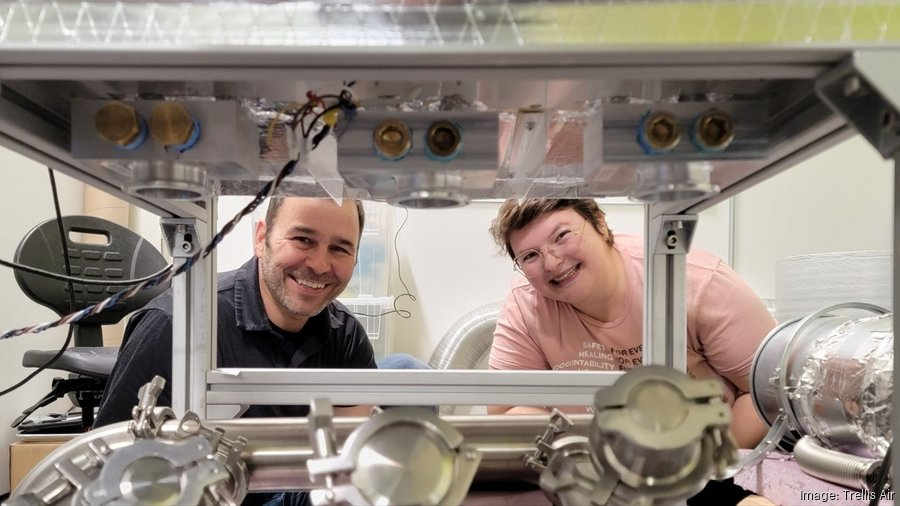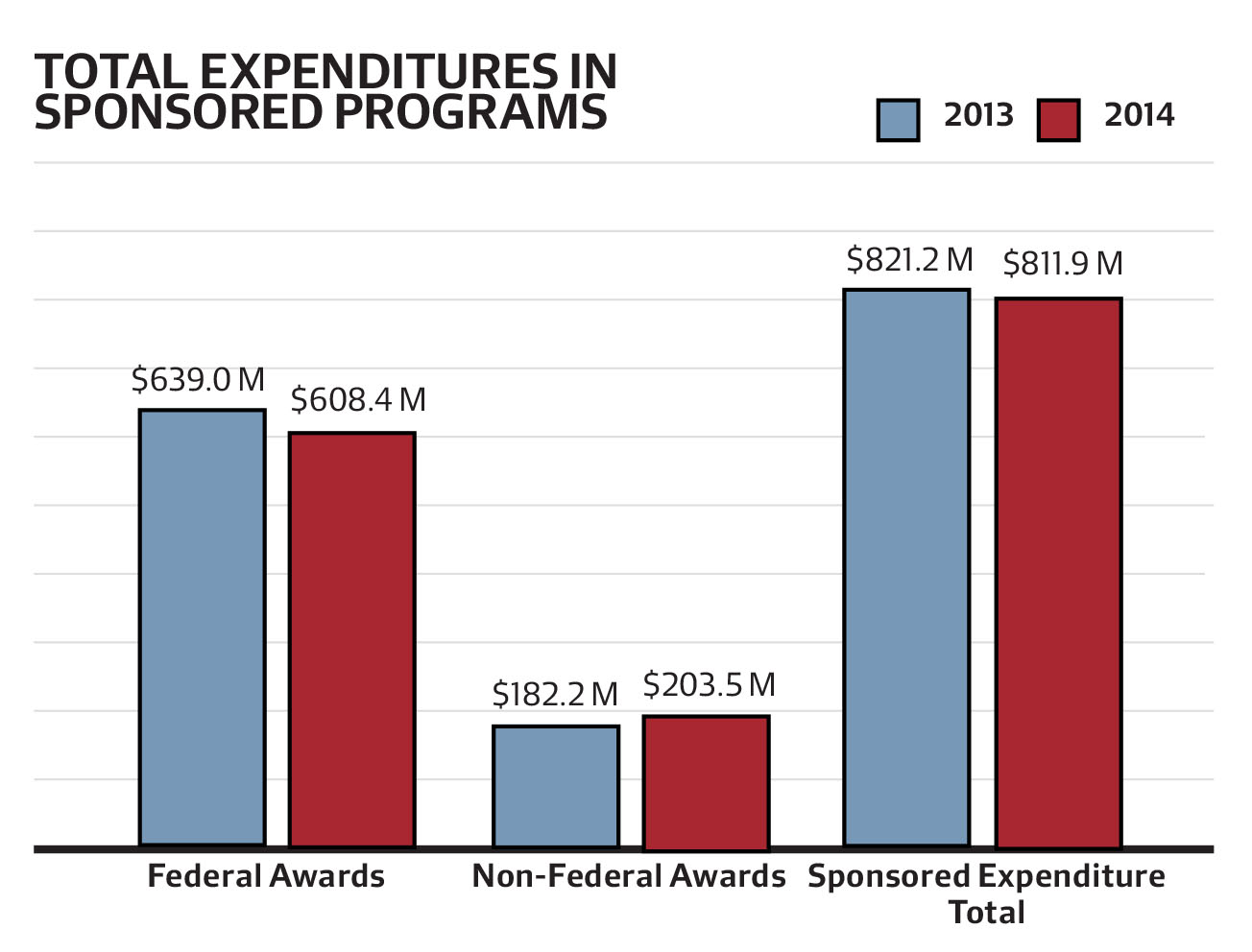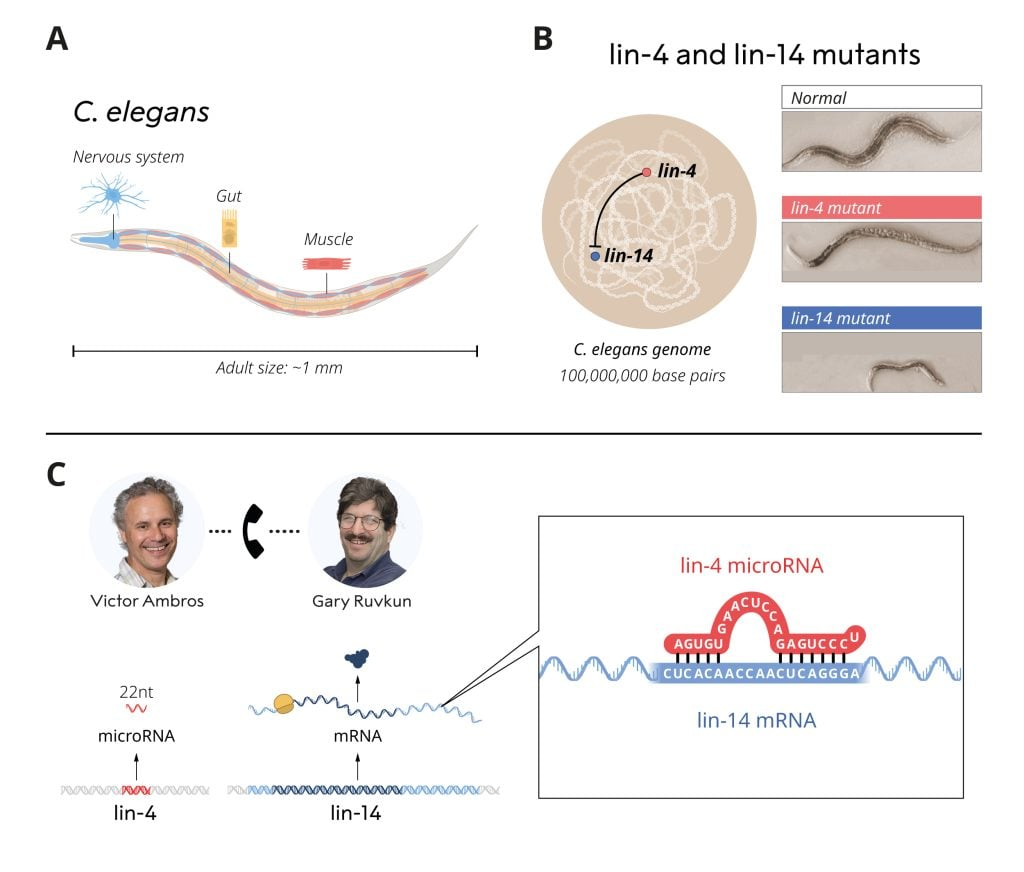
microRNA Discovery: The Journey to a 2024 Nobel Prize
MicroRNA discovery represents a groundbreaking milestone in our understanding of gene regulation, fundamentally altering the landscape of molecular biology. Pioneered by Nobel laureate Gary Ruvkun in the early 1990s, the work revealed the intricate roles that tiny RNA molecules play in gene expression across various organisms, including humans. Initially met with skepticism, this discovery gradually garnered attention, particularly through NIH funding and collaborative research efforts. Today, the significance of microRNAs extends beyond basic science, as innovative therapies targeting these molecules are undergoing clinical trials for diseases such as cancer and Alzheimer’s. As we delve into the lasting implications of microRNA research, it is clear that the journey from discovery to application has transformed the field of genetic science and therapeutic development.
The uncovering of small non-coding RNA molecules, known as microRNAs, constitutes a pivotal advance in the realm of genetic regulation. Initially characterized by researchers like Gary Ruvkun, this groundbreaking work revealed how these diminutive RNA entities influence gene expression and contribute to various biological processes. As scientific interest grew, particularly with the support of national institutes and funding bodies, these tiny molecules began to shed light on the complexities of genetic coding in multiple species. The potential therapeutic applications of microRNAs have not only enriched our understanding of molecular biology but also paved the way for clinical innovations aimed at treating chronic diseases. This evolution from basic research to therapeutic development underscores the importance of continued investment in scientific exploration.
The Groundbreaking Discovery of MicroRNA
The discovery of microRNA in 1992 by scientists Gary Ruvkun and Victor Ambros marked a pivotal moment in genetics. At the time, their work on the C. elegans roundworm was not widely recognized, but it laid the foundation for significant advancements in gene regulation research. This breakthrough has since become fundamental in understanding how tiny RNA molecules can control gene expression and influence various biological processes. The impact of this discovery has resonated throughout the scientific community and has been recognized with prestigious accolades, including the Nobel Prize in Physiology or Medicine in 2024.
MicroRNA’s role in gene regulation is not just limited to laboratory research; it has broadened into critical therapeutic applications. As ongoing research continues to reveal how microRNAs function in both plants and animals, their potential to treat diseases such as cancer and heart disease is rapidly being explored in clinical trials. The increased visibility and recognition of microRNA have spurred interest from varied fields of biology and medicine, leading to collaborative efforts that underscore its vital importance in scientific research.
Gary Ruvkun’s Journey and NIH Funding
Gary Ruvkun’s journey as a scientist highlights the crucial role of federal funding in advancing scientific innovation. Over the past four decades, Ruvkun has received significant support from the National Institutes of Health (NIH), allowing him to pursue groundbreaking research without the constraints often associated with private funding. Despite skepticism from the wider scientific community following his initial discoveries, Ruvkun’s persistence, bolstered by NIH funding, has catalyzed a wider acceptance of microRNA research. His lab’s findings reflect the potential of government support to drive societal progress through science.
The relationship between Ruvkun’s research and NIH funding encapsulates a broader narrative of how federal investments have shaped the landscape of biomedical research in the United States. With a steady flow of approximately $150,000 annually, Ruvkun has been able to maintain a small, dedicated team of researchers who contribute to these monumental breakthroughs in genetics. The stability provided by such funding is essential for nurturing scientific talent and innovation, particularly in an era where financial support is increasingly scrutinized.
Impacts of MicroRNA on Human Health
MicroRNAs have emerged as critical regulators in human health, influencing a myriad of physiological processes. Research indicates that humans possess approximately 1,000 distinct microRNAs, each capable of controlling the expression of a significant portion of protein-coding genes. This intricate network of gene regulation suggests that microRNAs could play essential roles in the development of various diseases, impacting conditions ranging from cancer to neurodegenerative disorders like Alzheimer’s. As researchers continue to uncover the complexities of these molecules, therapeutic interventions targeting microRNAs are beginning to take center stage.
Ongoing clinical trials are exploring the efficacy of microRNA-based therapies, presenting a promising avenue for disease treatment. Early-stage research into microRNA applications for heart disease and other chronic illnesses has shown encouraging results, showing potential not only for treatment but also for prevention. As the scientific community gathers momentum in this field, the intersection of microRNA research and clinical application solidifies its importance in shaping modern healthcare strategies.
The Evolution of MicroRNA Research
Since the initial discovery of microRNAs, research in this area has evolved dramatically, transitioning from basic science to a robust field with substantial clinical implications. As interest in microRNAs grew, so did the number of researchers and institutions working on this topic, leading to an exponential increase in scientific publications and collaborative efforts. Initiatives funded by the NIH have been instrumental in fostering this growth, enabling researchers to pursue innovative projects that unravel the complexities of gene regulation.
The transformation of microRNA research also parallels the evolution of technology in the life sciences. With advanced sequencing technologies and enhanced computational methods, scientists can now analyze microRNA functions with unprecedented precision. This revitalization of the field not only showcases the discoveries made by Ruvkun and Ambros but also emphasizes the collective international efforts to utilize microRNAs in developing groundbreaking therapeutic methods to combat serious health conditions.
The Importance of Federal Investment in Science
Federal funding has been a cornerstone of scientific advancement in the United States, providing the necessary resources for researchers to explore innovative ideas. Gary Ruvkun’s research is a testament to how NIH funding has facilitated groundbreaking discoveries in microRNA and gene regulation. Through strategic investments, the government has nurtured an environment where scientists can thrive and make significant contributions to knowledge and technology. Ruvkun’s advocacy for continued federal support reflects the understanding that science underpins much of modern innovation.
As discussions about budget cuts to scientific funding arise, Ruvkun highlights the potential negative impacts such measures could have on the next generation of scientists. A lack of investment may drive talented individuals away from research fields, hindering progress and innovation. Institutions that have nurtured robust scientific development depend on ongoing federal support to empower the workforce that will continue to push boundaries in medical and technological research.
MicroRNA and Its Role in Gene Regulation
The discovery of microRNAs has revolutionized our understanding of gene regulation. Initially, gene expression was thought to be a straightforward linear process, but microRNAs have introduced a layer of complexity in how genes are regulated. These small RNA molecules not only repress gene expression but also stabilize mRNA, making them essential players in cellular function. The implications of this dual role extend across various biological disciplines, from developmental biology to cancer research.
The integration of microRNAs into the broader understanding of gene regulatory networks has opened up new pathways for research and therapeutic targeting. Investigations into the precise mechanisms of microRNA action are crucial for elucidating their influence on numerous diseases. Continued exploration of their functional roles in different organisms may unlock additional therapeutic avenues, highlighting the importance of interdisciplinary collaboration in advancing this field of study.
Scientific Collaboration and MicroRNA Research
The journey of microRNA research has been marked by collaboration across various scientific disciplines. Initially rooted in studies of C. elegans, the revelations surrounding microRNAs have engaged biologists, geneticists, and medical professionals alike. The growing interest has fostered a collaborative spirit where ideas and findings regularly flow between laboratories and institutions. This interconnectedness is essential not just for the advancement of microRNA research but for the development of holistic approaches to healthcare.
Such collaborations often lead to multifaceted projects that target pressing health challenges, such as cancer and metabolic disorders. By harnessing diverse expertise, researchers can navigate the complexities of microRNA functions more effectively. As more scientists join the conversation, the potential applications of microRNAs in clinical settings expand, promising innovative solutions for diseases that currently lack effective treatments.
Nobel Recognition: Celebrating MicroRNA Discoveries
The Nobel Prize awarded to Gary Ruvkun and Victor Ambros in 2024 for their discovery of microRNAs serves as a significant recognition of their contributions to science. It not only honors their individual achievements but also sheds light on the essential role of microRNA research in advancing our understanding of gene regulation. This acknowledgment by the global scientific community signifies the importance of building on foundational research for future discoveries.
Celebrating such milestones emphasizes the ongoing need for rigorous scientific inquiry. The Nobel Prize raises awareness and inspires young researchers to delve into the complexities of genetics, including the roles of microRNAs. This recognition catalyzes interest and funding toward further research in the field, ensuring that the pursuit of knowledge continues to yield significant clinical applications and therapeutic innovations.
The Future of MicroRNA Research
As the scientific landscape continues to evolve, the future of microRNA research looks promising. With advancements in technology and an increasing understanding of genetic mechanisms, researchers are poised to unlock new therapeutic potentials that could revolutionize treatment protocols. The ongoing exploration of microRNAs in both fundamental biology and clinical applications holds the potential to yield significant advancements against a variety of diseases previously deemed challenging or insurmountable.
Moreover, interdisciplinary collaboration will play a critical role in shaping this future. By integrating insights from molecular biology, bioinformatics, and clinical medicine, researchers can develop comprehensive strategies for harnessing the power of microRNAs. As the field progresses, continued investment in research and education will be vital in ensuring that the potential of microRNAs is fully realized, maintaining a trajectory of discovery that enhances human health and well-being.
Frequently Asked Questions
What is microRNA discovery and why is it significant in gene regulation?
MicroRNA discovery refers to the identification of tiny RNA molecules that play a crucial role in gene regulation. This breakthrough, primarily attributed to Gary Ruvkun and Victor Ambros in 1992, revealed that microRNAs can inhibit gene expression, thereby influencing numerous developmental processes in organisms such as the C. elegans roundworm. Their discovery has profound implications for understanding biological systems and diseases, which ultimately earned them the 2024 Nobel Prize.
How did Gary Ruvkun’s research contribute to the understanding of microRNA?
Gary Ruvkun’s research significantly expanded the field of molecular biology by uncovering how microRNAs regulate gene expression. Through their groundbreaking work in C. elegans, Ruvkun and Ambros were able to show that microRNAs have conservation across various species, indicating their fundamental role in genetic regulation. This pioneering study laid the foundation for ongoing research into how microRNAs can be manipulated for therapeutic purposes.
What role did NIH funding play in the advancement of microRNA discovery?
NIH funding was pivotal in the advancement of microRNA discovery, supporting the early research efforts of Gary Ruvkun and Victor Ambros. The financial backing provided by the National Institutes of Health enabled researchers to delve into the mechanisms of gene regulation through microRNAs, which eventually led to significant breakthroughs that have shaped current molecular biology and therapeutic approaches.
What diseases are currently targeted in clinical trials using microRNA therapies?
Clinical trials are currently exploring therapies based on microRNA for various diseases, including heart disease, cancer, Crohn’s Disease, and Alzheimer’s. The ability of microRNAs to modulate gene expression offers promising avenues for treatment, showcasing their potential in clinical applications.
Why was the initial reaction to microRNA discovery in 1992 relatively subdued?
When Gary Ruvkun and Victor Ambros first published their findings on microRNA in 1993, the evolutionary biology community did not immediately recognize its significance; the focus was primarily on the C. elegans model organism. The broader implications of microRNAs on gene regulation in other species, including humans, were not fully appreciated until later, as interest in the field grew and researchers from various disciplines started to connect the dots.
How has microRNA research evolved since the initial discovery?
Since the initial discovery of microRNA, research has evolved significantly, leading to a deeper understanding of their role across various organisms. The field has expanded to examine the functional implications of microRNAs in gene regulation, maturation, and development, ultimately influencing modern therapeutic strategies. As a result, microRNAs are now recognized as key players in the biological processes of both plant and animal cells.
What is the future of microRNA discovery and research in the scientific community?
The future of microRNA discovery looks promising, with ongoing research targeting their therapeutic potential in various diseases. As the scientific community continues to explore mechanistic insights and clinical applications of microRNAs, advancements in this field could lead to innovative treatments and a better understanding of gene regulation in health and disease.
| Key Point | Details |
|---|---|
| Initial Discovery | In 1992, Gary Ruvkun and Victor Ambros discovered microRNA in C. elegans, a groundbreaking achievement that would later lead to the 2024 Nobel Prize. |
| Impact on Science | The discovery was initially met with skepticism but gradually gained recognition, linking microRNAs to various biological processes across species. |
| Funding and Support | Much of the research was funded by the National Institutes of Health, highlighting the importance of government support for scientific research. |
| Current Applications | MicroRNAs are now key players in therapies for diseases such as heart disease, cancer, Crohn’s Disease, and Alzheimer’s, with many treatments in clinical trials. |
| Economic Contribution | Ruvkun’s research contributed to the growth of companies focused on RNA therapeutics, showcasing the economic impact of scientific innovation. |
Summary
MicroRNA discovery has revolutionized our understanding of gene regulation and its effects on various biological processes. From the groundbreaking research of Gary Ruvkun and Victor Ambros in 1992 to the present day, the significance of microRNAs has become increasingly apparent. Their role in developing therapies for serious diseases highlights the profound impact that foundational research can have on both science and society.









